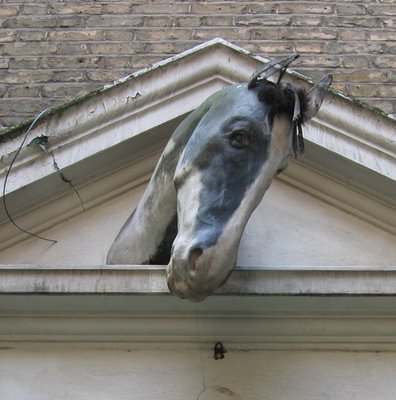I expected cellophane wrapped flowers and messages to appear at the spot the next day, but they never materialized. The street corner where it happened, and where I thought I could still see the blood stains for some days, remained unmarked and nondescript (the flowers, I learned later, were left outside his council bloc home, on the next street). The other London ritual associated with violent death was, however, inescapble. The yellow and black CAN YOU HELP US notice boards appeared in both ends of my new street, crying MURDER. In the strange and awkward police language they tell of a large street fight on Saturday before Christmas. "One male has since died, and another male has received severe wounds". Notice the passive form of the sentence, so popular in British English, and the almost zoological description of the victim.
The local papers have their own lingo, succinct and blood thirsty. "Teen Dies in Party Brawl" (Hackney Gazette) "26th Teenage Victim 2007" (Evening Standard; there was to be a 27th). Because of the holidays, the headlines remained in front of the shops for many days.
It is not the first time for me in London to come close to violence, or even to murder. The street is a quiet one; it feels much safer compared to some places I've lived in, but this is no more than a feeling. Violence is always a possibility, throughout the city. Like every Londoner, I have learned that in some situations it is best to look the other way, move to the other pavement.
On that night I came back and there was something wrong in the air: the sound of angry voices of teenage boys. Passed the street corner and from the neighbourhood club I could hear loud good hip-hop music. It felt alright again. But an hour later the music suddenly stopped, and all I could hear were the angry voices. When I went out to put the recycling, I saw a group of kids chasing two or three other kids. There were hatred and fear in the eyes. This was not a game.
Once before I had seen a young man in his twenties chased by a group of 10-15 teenagers. I can still see the look in his eyes: the raw panic of a hunted animal. I was cycling down Cable Street, and just passed the big mural commemorating the street fight against the Fascists in the 1930s, when I passed a man running from his cheering pursuers. I saw them catching up with him, bringing him down to the floor, and the kicking started. I cycled away, as fast as I could. I would have probably called the police but I didn't have my mobile. The next day I looked in the papers for a mention of the incident. There was nothing.
This time, again, I went inside and closed the door behind me. I wondered if any of the neighbours called the police. Shortly afterwards there was a siren, but only one. Nothing happened then, I thought, just some kids having a fight. The police always make a big hu-ha whenever they arrive, it's part of their tactics. Always more than one car, never a single siren. But the next day the street was blocked. A sixteen year was stabbed to death.
The street remains quiet as it was before. Old men in the morning on their way to the local clinic. Fathers and mothers taking their kids back from school in the afternoon. A couple of council estates; one gated-community and a building of converted over-priced "lofts". Turks, Africans, English and other tribes; and a very tall tree, and a pile of rubbish, just next to the police notice board, which will probably go soon.

Sunday, January 06, 2008
Subscribe to:
Post Comments (Atom)


No comments:
Post a Comment